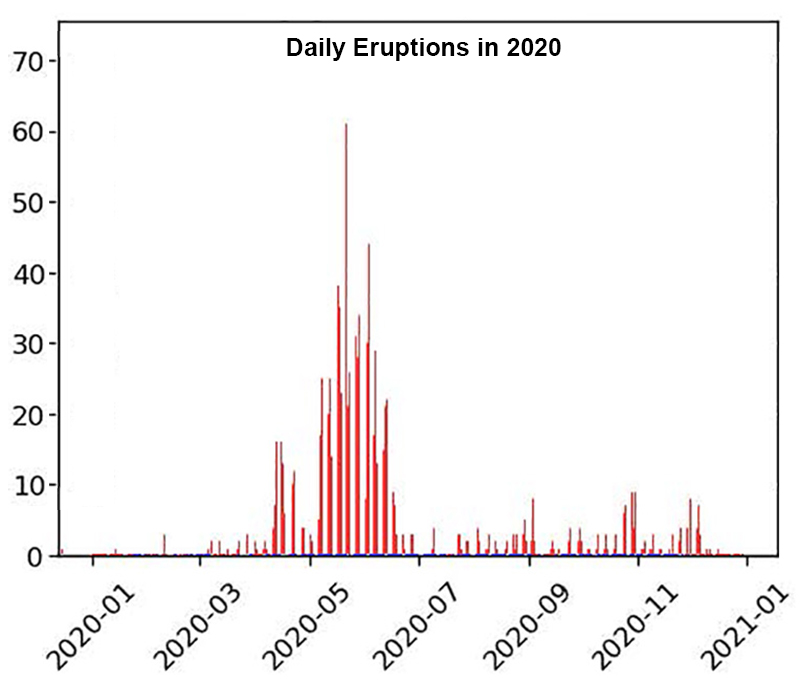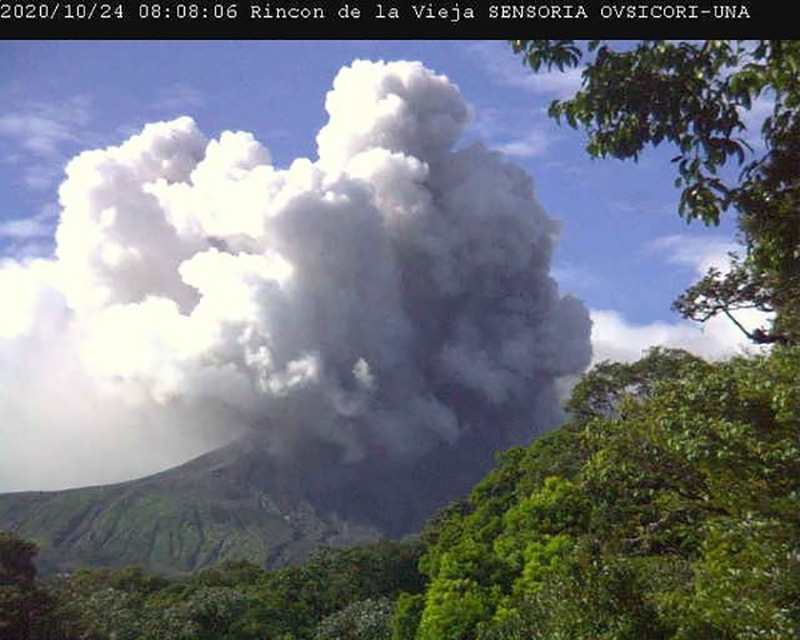Report on Rincon de la Vieja (Costa Rica) — March 2021
Bulletin of the Global Volcanism Network, vol. 46, no. 3 (March 2021)
Managing Editor: Edward Venzke.
Research and preparation by Paul Berger.
Rincon de la Vieja (Costa Rica) Frequent small phreatic explosions through 13 December 2020
Please cite this report as:
Global Volcanism Program, 2021. Report on Rincon de la Vieja (Costa Rica) (Venzke, E., ed.). Bulletin of the Global Volcanism Network, 46:3. Smithsonian Institution. https://doi.org/10.5479/si.GVP.BGVN202103-345020
Rincon de la Vieja
Costa Rica
10.83°N, 85.324°W; summit elev. 1916 m
All times are local (unless otherwise noted)
Recent activity at Rincón de la Vieja has been dominated by frequent weak phreatic explosions, with an occasional ash plume, along with gas-and-steam emissions. Sporadic lahars have also been recently reported (BGVN 45:10). The volcano has a hot, churning, acid lake in its main crater. The current report describes activity during October 2020-February 2021, a continuation of the most recent eruptive period that began in January 2020. The primary information source for this report is weekly bulletin from the Observatorio Vulcanologico Sismologica de Costa Rica-Universidad Nacional (OVSICORI-UNA).
According to OVSICORI-UNA, small but frequent hydrothermal explosions continued in October through mid-December 2020, although less energetic than during previous months (figure 34). During the first half of October there were 1-2 daily small explosions. Plumes often rose 500-800 m above the crater rim, but on 1 and 6 October they rose 1 km. Then the number briefly increased to 5-7 small daily explosions before decreasing during the latter part of October; one explosion seen in webcam images on 24 October sent a plume to 1 km above the crater (figure 35).
OVSICORI-UNA reported that in November small-to-moderate hydrothermal explosions increased in amplitude, but became more sporadic and by the end of the month had decreased to only one per day. An explosion at 0835 on 3 November produced a plume that rose 800 m above the crater rim. According to OVSICORI’s weekly bulletin for 23 November, there had been 1,437 explosions since the beginning of 2020. A large explosion on 13 December was the last through at least February 2021. During the week of 18 January OVSICORI changed the Alert Level from 3 to 2 due to the low level of activity.
Geodesic monitoring at the summit by GPS indicated no deformation trend in October, significant contraction in November, some extension in December, but then no significant changes through at least February 2021. Aerial observations on 13 February indicated that the crater lake was at a low water level and had sustained convection. The lake level had dropped 15-20 m since February 2020, and 5-10 m since May 2020. Gas monitoring during October 2020-February 2021 was carried out at the Ojo de Agua Santuarium (4 km N of the active crater); sulfur dioxide in the plume was not detected in significant quantities.
Geological Summary. Rincón de la Vieja, the largest volcano in NW Costa Rica, is a remote volcanic complex in the Guanacaste Range. The volcano consists of an elongated, arcuate NW-SE-trending ridge constructed within the 15-km-wide early Pleistocene Guachipelín caldera, whose rim is exposed on the south side. Sometimes known as the "Colossus of Guanacaste," it has an estimated volume of 130 km3 and contains at least nine major eruptive centers. Activity has migrated to the SE, where the youngest-looking craters are located. The twin cone of Santa María volcano, the highest peak of the complex, is located at the eastern end of a smaller, 5-km-wide caldera and has a 500-m-wide crater. A Plinian eruption producing the 0.25 km3 Río Blanca tephra about 3,500 years ago was the last major magmatic eruption. All subsequent eruptions, including numerous historical eruptions possibly dating back to the 16th century, have been from the prominent active crater containing a 500-m-wide acid lake located ENE of Von Seebach crater.
Information Contacts: Observatorio Vulcanologico Sismologica de Costa Rica-Universidad Nacional (OVSICORI-UNA), Apartado 86-3000, Heredia, Costa Rica (URL: http://www.ovsicori.una.ac.cr/, https://www.facebook.com/OVSICORI/); The Nacion (URL: https://www.nacion.com/).



